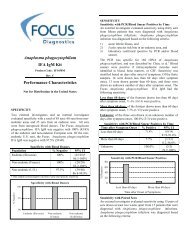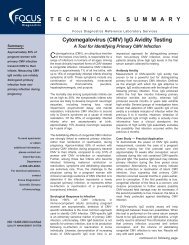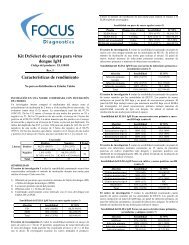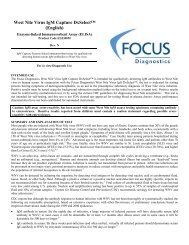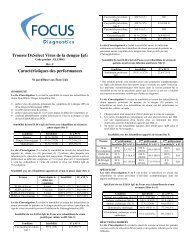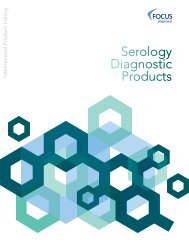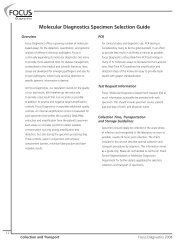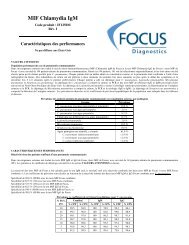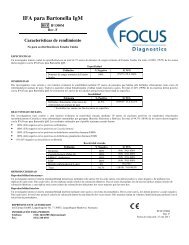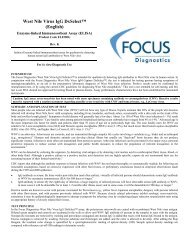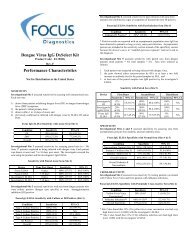HerpeSelect® 2 ELISA IgG test is intended for - Focus Diagnostics
HerpeSelect® 2 ELISA IgG test is intended for - Focus Diagnostics
HerpeSelect® 2 ELISA IgG test is intended for - Focus Diagnostics
- No tags were found...
You also want an ePaper? Increase the reach of your titles
YUMPU automatically turns print PDFs into web optimized ePapers that Google loves.
HerpeSelect ® 2 <strong>ELISA</strong> <strong>IgG</strong>Page 6Cross-reactivity with Taxonomically Related Viruses<strong>Focus</strong> assessed the device’s cross-reactivity using sera (n = 27) from 1) HSV sero-negative by another manufacturer’s FDA cleared HSV <strong>ELISA</strong>s, and 2) IFA<strong>IgG</strong> positive <strong>for</strong> taxonomically similar viruses including CMV, EBV VCA, HHV6 and VZV. D<strong>is</strong>crepants between the FDA cleared HSV <strong>ELISA</strong>s and the <strong>Focus</strong>device were analyzed using a type specific Western Blot from a Pacific Northwest university.Cross-reactivity with Taxonomically Related Viruses (n = 27)IFA <strong>IgG</strong> Pos % Agreement Negative* 95%CICMV 91.7% (11/12) 61.5-99.8%EBV VCA 90.9% (20/22) 70.8-98.9%HHV6 90.9% (20/22) 70.8-98.9%VZV 90.5% (19/21) 69.6-98.8%Total 90.9% (70/77) 82.2-96.3%* Excludes 3 Western Blot positives, and 1 d<strong>is</strong>crepant that was not analyzed with the Western Blot because of insufficient volume.Intra-assay and Inter-assay ReproducibilityAn internal investigator assessed the device’s intra-assay and inter-assay reproducibility by assaying 7 samples in duplicate, twice a day, <strong>for</strong> 20 days, <strong>for</strong> a totalof 40 runs. 2 sets of samples were masked duplicates.Inter-lot ReproducibilityAn internal investigator assessed the device’s inter-lot reproducibility. 5 samples were run on 3 separate days with 3 separate lots. For 1 lot, the samples were runin triplicate, and run in duplicate with the other 2 lots. Each of the 3 lots had a different lot of Antigen Wells.Inter-laboratory ReproducibilityAn internal investigator and 2 off-site laboratories assessed the device’s inter-laboratory reproducibility. Each of the 3 laboratories ran 7 samples in triplicate on3 different days. 3 points were excluded because an incorrect sample (instead of sample 27) was run 1 day.ReproducibilityInter- & Intra-assay Inter-lot Inter-labSampleIntra-assay Inter-assay%CV of LabIndex MeanIndex Mean Index %CV Index Mean%CV %CVMeansLabMean of %CVs21* 0.18 20.5% 15.9% 0.28 52.4% 0.23 19.6% 17.3%26* 0.18 12.2% 12.4% NA NA 0.26 33.1% 20.7%22** 1.23 6.3% 6.2% 1.16 5.1% 1.19 3.9% 7.8%27** 1.22 5.2% 6.3% NA NA 1.14 14.1% 8.8%23 1.79 4.7% 5.5% 1.76 5.4% 1.73 5.2% 7.1%24 3.42 3.2% 7.9% 3.18 16.7% 2.77 11.0% 10.8%25 8.17 3.0% 6.9% 7.99 7.4% 6.82 18.6% 4.5%* #21 & #26 are same material.** #22 & #27 are same material.% Agreement between the Manual and Automated Methods (n = 257)An internal and an external investigator compared % agreement between the HerpeSelect automated method vs. the manual method as part of a CLIA validation<strong>for</strong> a major clinical laboratory located in Southern Cali<strong>for</strong>nia. The external investigator sequentially selected and manually <strong>test</strong>ed 257 samples. Each sample wasfrom an adult, and was submitted <strong>for</strong> HSV <strong>test</strong>ing. 255 samples were from the U.S., and 2 samples from outside the U.S. Of the 257 samples, the manual methoddetected 175 negatives, 3 equivocals, and 79 positives. Of the 175 negatives by the manual method, the automated method agreed with 99.4% (174/175). Of the 3equivocals by the manual method, the automated method agreed with 0% (0/3). Of the 79 positives by the manual method, the automated method agreed with98.7% (78/79). Overall, the 2 methods agreed 98.1% (252/257). Of the 5 d<strong>is</strong>crepants, 2 resolved in favor of the automated method, and the other 3 did notresolve.% Agreement between Manual and Automated MethodsInterpretation* % Agreement 95%CINegative 99.4% (174/175) 96.4-100%Equivocal 0.0% (0/3) 0.0-70.8%Positive 98.7% (78/79) 93.1-100%Overall 98.1% (252/257) 95.5-99.4%* Interpretation by manual method.Reproducibility Using an Automated InstrumentAn internal investigator assessed the device’s inter-assay and intra-assay reproducibility with an automated instrument. 10 samples were <strong>test</strong>ed in triplicate on 3different days. The manual and automated methods agreed 98.9% (89/90). 1 point from Sample 3 was an outlier (162 standard deviations from the mean).Stability after Opening ReagentsAn internal investigator assessed stability after the reagents had been opened and used with an automated instrument. The kit was used in the inter-assay/intraassayreproducibility study (above), re-closed, stored at 2 to 8°C <strong>for</strong> at least 30 days, and then used again to re-<strong>test</strong> the same samples. There was 100% agreementwith the index when the reagents were opened.REFERENCES1. Aurelian, L. Herpes Simplex Viruses. 473-497. In Specter, S & G Lancz (eds.). Clinical Virology Manual. 2 nd Ed. Elsevier, New York. (1992).2. Centers <strong>for</strong> D<strong>is</strong>ease Control and Prevention. Sexually transmitted d<strong>is</strong>eases treatment guidelines 2002. MMWR 2002:5 1 (No. RR-6).3. Arvin, A, C Prober. Herpes Simplex Viruses. 876-883. In Murray, P, E Baron, M Pfaller, F Tenover, and R Yolkenet (eds.). Manual of Clinical Microbiology. 6th Ed. ASM,Washington, D.C. (1995).4. Whitley, R. Herpes Simplex Viruses. 2297-223 1. In Fields, B, D Knipe, P Howley, et al. (eds.). Fields Virology 3 rd Ed. Lippincott-Raven, Philadelphia. (1996).5. Whitley, R, A Nahmias, A V<strong>is</strong>intine, C Fleming, C Al<strong>for</strong>d. Natural h<strong>is</strong>tory of herpes simplex virus infection of mother and newborn. Pediatrics 66:489-494 (1980).6. Whitley, R. Herpes simplex, in J Klein & J Remington (ed.), Infectious d<strong>is</strong>eases of the fetus and newborn infants, 3 rd ed., p.282-305.7. Prober, C, W Sullender, L Yasukawa, D Au, A Yaeger, A Arvin. Low r<strong>is</strong>k of herpes simplex virus infections in neonates exposed to the virus at the time of vaginal delivery tomothers with recurrent herpes simplex virus infections. N Engl J Med 3 16:240-244 (1987).8. Brown, Z, S Sleke, J Zeh, J Kopelman, A Maslow, R Ashley, D Watts, S Berry, M Herd, L Correy. The acqu<strong>is</strong>ition of herpes simplex virus during pregnancy. N Engl J Med337:509-515 (1997).9. Prober CG, Corey L, Brown ZA et al. 1992. The management of pregnancies complicated by genital infections with herpes simplex virus. Clin Infect D<strong>is</strong>. 15:1031-1038.



